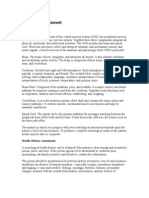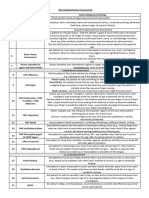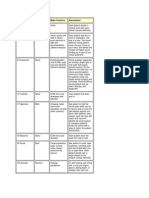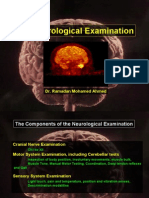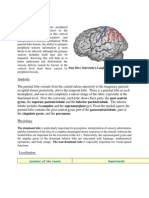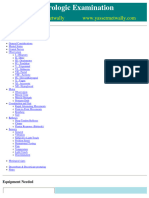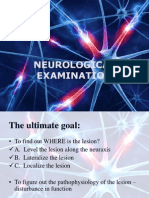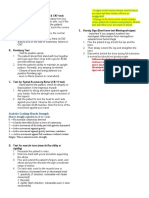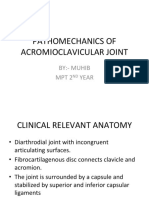Box 10
Box 10
Uploaded by
stx863Copyright:
Available Formats
Box 10
Box 10
Uploaded by
stx863Copyright
Available Formats
Share this document
Did you find this document useful?
Is this content inappropriate?
Copyright:
Available Formats
Box 10
Box 10
Uploaded by
stx863Copyright:
Available Formats
Box 10.
4 Comprehensive screening neurological examination Conscious level and cognitive function (determined during history taking) Is the patient's conscious level clouded? Is the history given accurately, concisely and with insight? Or is the patient concrete, circumlocutory or vague? Is the patient neatly dressed and well cared for? Is the patient's behaviour normal? Is the patient aphasic or dysarthric? Vision Acuity: For each eye, using normal refractive correction, test ability to read small and large print, or use Snellen chart if available. If this fails, test counting of fingers, perception of light. Visual fields: Test all four quadrants for each eye individually. Fundi: Check for papilloedema, optic atrophy, retinopathy. Pupils: Check equality and consensual and direct reactions to light and accommodation. Eye movements Test both eyes together in 'H' pattern for range of movement and diplopia. Test both eyes together in '+' pattern for smooth pursuit and nystagmus. Remainder of cranial nerves Nerve V: Pinprick on left and right in ophthalmic, maxillary and mandibular distributions; clenching of teeth; jaw jerk. Nerve VII: Appearance and symmetry; screwing up eyes against pressure, forcing lips closed against pressure, blink reflexes. Nerve VIII: Hear whispered numbers in each ear. Nerves IX and X: Ask patient to say 'ah' and observe palate. Nerve XI: Ask patient to shrug shoulders and move head to either side and flex against resistance while you observe sternomastoids. Nerve XII: Inspect tongue. Ask patient to protrude tongue and press against inside of cheek on either side. Limbs and trunk Inspection for wasting, fasciculation, skin lesions. Posture of outstretched arms with wrists pronated and supinated, looking for drift, tremor, abnormal movements. Tone at wrist, elbows, knees and ankles, ankle clonus. Power of proximal, axial and distal muscles on both sides. Co-ordination: Finger-nose test; rapid alternating movements; heel-shin test. Reflexes: Deep tendon reflexes of biceps, supinator, triceps, fingers, quadriceps, gastrocnemius; plantar responses. Sensation: Test pinprick distally to proximally up arms and legs medially and laterally; and up trunk bilaterally, anteriorly and posteriorly. Vibration sense or joint position sense at little finger, great toe (moving proximally if failed). Gait and stance Observe walking pattern. Standing still with feet together and eyes closed. Walking heel to toe. Jumping and hopping. The conscious level is best assessed by observation while taking the history. Severe disturbance should be quantified by the GCS score, but delirium can be gauged objectively by the first parts of the MiniMental State Examination (MMSE; see Chapter 3), namely orientation and repetition. Digit span, where the patient must immediately repeat a series of numbers ('a telephone number') called out by the examiner, is a good test for delirium. Even a moderately severely demented patient will be able to repeat a six-digit number successfully. If a wide-awake patient without severe dementia fails this test, he or she may have a specific aphasia in the domain of repetition, or hysterical or depressive pseudodementia. Spelling 'world' forwards (preserved even in severe dementia) and then backwards (requiring concentration, organization and 'internal repetition') is another cognitive test relatively sensitive to mild states of delirium. INTERPRETATION Clouding of consciousness may result from acute diffuse cerebral dysfunction, e.g. in cerebral hypoperfusion, metabolic disease or encephalitis. Focal lesions of the thalamus, especially if medial and bilateral, can also cause delirium, and lesions of the brainstem reticular activating system cause a
markedly impaired conscious level. Altered conscious level makes cognitive assessment largely redundant. There is little point in going through the whole MMSE if the patient cannot hold enough mental focus to repeat a six-digit number.
You might also like
- Budokonryoga Primary Series Cueing GuideDocument24 pagesBudokonryoga Primary Series Cueing GuideLuz GarciaNo ratings yet
- HISTORYDocument17 pagesHISTORYAshutosh Shukla T8 407No ratings yet
- Neurologic System LecutreDocument47 pagesNeurologic System LecutrePauline An Toni CapurihanNo ratings yet
- Nervous System Exam NotesDocument14 pagesNervous System Exam NotesGayathri GellaNo ratings yet
- The Neurological Exam: Mental Status ExaminationDocument13 pagesThe Neurological Exam: Mental Status ExaminationShitaljit IromNo ratings yet
- Cranial Nerves ExaminationDocument25 pagesCranial Nerves Examinationnaveenarageson4No ratings yet
- NeurologicalDocument11 pagesNeurologicalHiba V.ANo ratings yet
- The Neurological Exam: Respect and Kindness. When You Enter TheDocument9 pagesThe Neurological Exam: Respect and Kindness. When You Enter TheRemelou Garchitorena Alfelor100% (1)
- Chapter 8Document6 pagesChapter 8selva0315No ratings yet
- FizzaDocument7 pagesFizzaMoona KhanNo ratings yet
- Neurological AssessmentDocument113 pagesNeurological AssessmentAkshay BadoreNo ratings yet
- CRANIALDocument11 pagesCRANIALDemianaNo ratings yet
- Assignment of Neurology (Repaired) .Docx - 1494344936467Document24 pagesAssignment of Neurology (Repaired) .Docx - 1494344936467Amrit Preet KaurNo ratings yet
- Paediatric Neurological Examination: Dr. Salah Abdulkareem AlmezoriDocument50 pagesPaediatric Neurological Examination: Dr. Salah Abdulkareem AlmezoriAqid Hasan YBoyNo ratings yet
- Neuro and Cranial Nerve Assessment GuideDocument1 pageNeuro and Cranial Nerve Assessment GuidepriyaNo ratings yet
- Module 2 Physical AssessmentDocument8 pagesModule 2 Physical AssessmentMaria EsNo ratings yet
- Assessment of The Nervous SystemDocument49 pagesAssessment of The Nervous Systemnovita100% (1)
- Neuro ExamDocument25 pagesNeuro ExamkamalNo ratings yet
- Neurological AssessmentDocument7 pagesNeurological AssessmentSharon LawrenceNo ratings yet
- Neurological Assessment2Document14 pagesNeurological Assessment2Hana F. BarakatNo ratings yet
- Neurological AssessmentDocument13 pagesNeurological AssessmentJamaica Manuel IglesiasNo ratings yet
- Neurologic ExaminationDocument116 pagesNeurologic ExaminationMikylla OrdanielNo ratings yet
- CranialNrvDocument20 pagesCranialNrvS ArtNo ratings yet
- Session 4 Skills.......Document18 pagesSession 4 Skills.......Harry ChauhanNo ratings yet
- Cranial Nerve AssessmentDocument2 pagesCranial Nerve AssessmentTina RyanNo ratings yet
- Supplement 2 Introducing The Neurological Examination in 5 SessionsDocument4 pagesSupplement 2 Introducing The Neurological Examination in 5 SessionsAli AlisonNo ratings yet
- Pocket Card HEENT Assessment January2024Document3 pagesPocket Card HEENT Assessment January2024adnan MukhtarNo ratings yet
- Assessing Cranial Nerve FunctionDocument1 pageAssessing Cranial Nerve FunctionSITTIE JOBAISAH TOMINAMAN ALINo ratings yet
- Assessing The Neurologic System PDFDocument10 pagesAssessing The Neurologic System PDFYudi TrigunaNo ratings yet
- Nerve Classification Major Functions AssessmentDocument2 pagesNerve Classification Major Functions AssessmentMeLissa Pearl GuillermoNo ratings yet
- PX NN CranialDocument35 pagesPX NN CranialZenithaMeidaNo ratings yet
- Neuro Exam ReviewDocument6 pagesNeuro Exam ReviewDianne Flores100% (2)
- Sensory Examination and CoordinationDocument7 pagesSensory Examination and CoordinationFatimah Alsultan100% (2)
- ASSESSMENT OF THE NERVOUS SYSTEM (230 NursDocument72 pagesASSESSMENT OF THE NERVOUS SYSTEM (230 Nursriya priya100% (1)
- Neurologic AssessmentDocument7 pagesNeurologic AssessmentFerric Lapenas100% (1)
- Cerebellar Examination OSCE GuideDocument11 pagesCerebellar Examination OSCE GuideLeen abusarhanNo ratings yet
- 1 - Neuro Assessment 2021 - 336Document30 pages1 - Neuro Assessment 2021 - 336HADI BADWAN100% (2)
- Canas, Patricia Gan, Razel Ruelo, Vanessa Aquino, Camile Guillano, Christabelle BSN IiiDocument73 pagesCanas, Patricia Gan, Razel Ruelo, Vanessa Aquino, Camile Guillano, Christabelle BSN IiiGan BangNo ratings yet
- Neuroscience - 4.3 - Examination of Cerebellar Systems and Meninges (KSD)Document4 pagesNeuroscience - 4.3 - Examination of Cerebellar Systems and Meninges (KSD)Kevin C. AguilarNo ratings yet
- Health Assessment Lesson 1Document44 pagesHealth Assessment Lesson 1Bernice EbbiNo ratings yet
- Examination of the Eyes and Vision - OSCE GuideDocument12 pagesExamination of the Eyes and Vision - OSCE GuideRayNo ratings yet
- Nursing Care of NeurologicDocument12 pagesNursing Care of NeurologicCharina AubreyNo ratings yet
- CRANIAL-NERVE-EXAMINATION (1)Document10 pagesCRANIAL-NERVE-EXAMINATION (1)Vignesh VigneshNo ratings yet
- Neurological ExaminationDocument240 pagesNeurological Examinationramadan0% (1)
- Neuro 1 and 2 LabDocument3 pagesNeuro 1 and 2 LabHardikPatelNo ratings yet
- Neurological AssessmentDocument76 pagesNeurological Assessmentjcabatit3No ratings yet
- Cranial Nerve ExaminationDocument10 pagesCranial Nerve ExaminationVignesh VigneshNo ratings yet
- Name: Patient TL Age: Years Old Diagnosis: Physical AssessmentDocument11 pagesName: Patient TL Age: Years Old Diagnosis: Physical AssessmentJazzmin Angel ComalingNo ratings yet
- Assessment of The Nervous System - FinalDocument76 pagesAssessment of The Nervous System - FinalRona Lucido100% (1)
- Heent LabDocument11 pagesHeent Labapi-743783774No ratings yet
- neurological examinationDocument39 pagesneurological examinationvaishrai.98No ratings yet
- ASESSMENT of Client With Diseases in Nervous SystemDocument16 pagesASESSMENT of Client With Diseases in Nervous SystemChristian San Jose TanNo ratings yet
- Examination of Cerebellum /cerebellar FunctionDocument5 pagesExamination of Cerebellum /cerebellar FunctiontruftybonesNo ratings yet
- Ex - Cerebellar ExamDocument2 pagesEx - Cerebellar ExamssNo ratings yet
- Parietal Lobe TestingDocument5 pagesParietal Lobe TestingvinodksahuNo ratings yet
- Neuro 101: Nursing Neuro Assessment: Kristen Ankrom, RN, SCRN, CCCC Stroke Coordinator Coliseum Medical CentersDocument29 pagesNeuro 101: Nursing Neuro Assessment: Kristen Ankrom, RN, SCRN, CCCC Stroke Coordinator Coliseum Medical CentersDarvin MathewNo ratings yet
- Eye AssessmentDocument7 pagesEye AssessmentPuviyarasiNo ratings yet
- Neurology Text For AssessmentDocument20 pagesNeurology Text For AssessmentVanlalruatfela HmarNo ratings yet
- Neurological ExaminationDocument58 pagesNeurological ExaminationMartin Ogbac100% (4)
- Ortho Neuro ExamsDocument0 pagesOrtho Neuro ExamsMaybs Palec Pamplona-ParreñoNo ratings yet
- Mr. P - 33 YO - Maxillofacial Trauma.Document24 pagesMr. P - 33 YO - Maxillofacial Trauma.Sandi TamaNo ratings yet
- Fall 2022 - ZOO403 - 1 - BC190408115Document4 pagesFall 2022 - ZOO403 - 1 - BC190408115Misbah NoreenNo ratings yet
- Skull of The Dog PDFDocument3 pagesSkull of The Dog PDFgbvvsvvpyvNo ratings yet
- Review of Anthropometric Considerations For Tractor Seat DesignDocument9 pagesReview of Anthropometric Considerations For Tractor Seat DesignRicardo BetetaNo ratings yet
- Your Amazing Body 6Document31 pagesYour Amazing Body 6hendrixsmaymNo ratings yet
- The Human Body: An Orientation: Chapter 1 Part BDocument32 pagesThe Human Body: An Orientation: Chapter 1 Part Bterryortiz825No ratings yet
- AAN CONTINUUM Approach To Peripheral Neuropathy Localization and DiagnosisDocument26 pagesAAN CONTINUUM Approach To Peripheral Neuropathy Localization and Diagnosisemilly vidyaNo ratings yet
- 9 Cephalometric Analysis 2Document96 pages9 Cephalometric Analysis 2Mei Xiao100% (1)
- BPI Muscle Test For Poli 1Document2 pagesBPI Muscle Test For Poli 1theo siwuNo ratings yet
- Science 9 - Q1 - Mod1 - Respiratory and Circulatory System - VerFINALDocument35 pagesScience 9 - Q1 - Mod1 - Respiratory and Circulatory System - VerFINALJames Denzyl GadianaNo ratings yet
- Anterior Cruciate Ligament InjuryDocument3 pagesAnterior Cruciate Ligament InjuryAdrian Nazario PragachaNo ratings yet
- Dry Needling Case Studies 1-5Document13 pagesDry Needling Case Studies 1-5munesh shrivastvaNo ratings yet
- NCMA121.HAs - RLE PHYSICAL ASSESSMENT ADULT PART 1Document3 pagesNCMA121.HAs - RLE PHYSICAL ASSESSMENT ADULT PART 1Rowena SamsonNo ratings yet
- Endocrine System HandoutsDocument5 pagesEndocrine System HandoutsBeatriz IcayNo ratings yet
- NEURO - Retdem: A. Testing For Corneal Reflex (CN5 & CN7 Test)Document1 pageNEURO - Retdem: A. Testing For Corneal Reflex (CN5 & CN7 Test)Peter GirasolNo ratings yet
- Pathomechanics of Acromioclavicular JointDocument28 pagesPathomechanics of Acromioclavicular JointMuhib ArfinNo ratings yet
- NexGen Pocket Profiler FinalDocument287 pagesNexGen Pocket Profiler Finalprasherpratik1984No ratings yet
- Metabolism: Endocrine SystemDocument125 pagesMetabolism: Endocrine Systemyer tagalajNo ratings yet
- I. Purposes of Antenatal ExerciseDocument4 pagesI. Purposes of Antenatal ExercisePabhat KumarNo ratings yet
- Fish Pituitary Extraction: ZOOL-707 3 (2-2) Comparative EndocrinologyDocument8 pagesFish Pituitary Extraction: ZOOL-707 3 (2-2) Comparative EndocrinologyIffiNo ratings yet
- 13 Motor Control and Reflexes Edit NOquesDocument22 pages13 Motor Control and Reflexes Edit NOquesugjdk djfgNo ratings yet
- The Voice Production Process: Presented By: Group 3Document24 pagesThe Voice Production Process: Presented By: Group 3Anjene MarieNo ratings yet
- Feline Neurological ExamDocument161 pagesFeline Neurological Examaurora heryantiNo ratings yet
- Duane SyndromeDocument27 pagesDuane SyndromeAlphamaleagainNo ratings yet
- Thyroid and AnesthesiaDocument50 pagesThyroid and Anesthesiayishakemekonene850No ratings yet
- A Compendium of The Anatomy of The Human Body 1807 PDFDocument482 pagesA Compendium of The Anatomy of The Human Body 1807 PDFGabriel MedinaNo ratings yet
- Anatomic Considerations in Dental Implant Surgery: Mitra SadrameliDocument22 pagesAnatomic Considerations in Dental Implant Surgery: Mitra SadrameliSebastián BernalNo ratings yet
- Circle of WillisDocument12 pagesCircle of Willisveegeer100% (1)
- Solomomow 2006 Ligamento y Control MotorDocument19 pagesSolomomow 2006 Ligamento y Control MotorBeto RebolledoNo ratings yet









